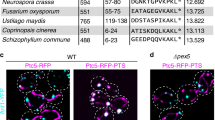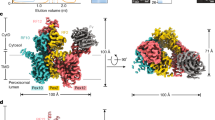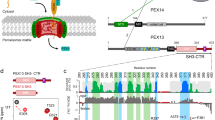Abstract
Peroxisomal import receptors bind their cargo proteins in the cytosol and target them to docking and translocation machinery at the peroxisomal membrane (reviewed in ref. 1). The receptors release the cargo proteins into the peroxisomal lumen and, according to the model of cycling receptors, they are supposed to shuttle back to the cytosol. This shuttling of the receptors has been assigned to peroxins including the AAA peroxins Pex1p and Pex6p, as well as the ubiquitin-conjugating enzyme Pex4p (reviewed in ref. 2). One possible target for Pex4p is the PTS1 receptor Pex5p, which has recently been shown to be ubiquitinated3,4,5. Pex1p and Pex6p are both cytosolic and membrane-associated AAA ATPases of the peroxisomal protein import machinery, the exact function of which is still unknown. Here we demonstrate that the AAA peroxins mediate the ATP-dependent dislocation of the peroxisomal targeting signal-1 (PTS1) receptor from the peroxisomal membrane to the cytosol.
This is a preview of subscription content, access via your institution
Access options
Subscribe to this journal
Receive 12 print issues and online access
$209.00 per year
only $17.42 per issue
Buy this article
- Purchase on Springer Link
- Instant access to full article PDF
Prices may be subject to local taxes which are calculated during checkout




Similar content being viewed by others
References
Lazarow, P. B. Peroxisome biogenesis: advances and conundrums. Curr. Opin. Cell Biol. 15, 489–497 (2003).
Brown, L. A. & Baker, A. Peroxisome biogenesis and the role of protein import. J. Cell. Mol. Med. 7, 388–400 (2003).
Platta, H. W., Girzalsky, W. & Erdmann, R. Ubiquitination of the peroxisomal import receptor Pex5p. Biochem. J. 384, 37–45 (2004).
Kiel, J. A., Emmrich, K., Meyer, H. E. & Kunau, W. H. Ubiquitination of the PTS1 receptor, Pex5p, suggests the presence of a quality control mechanism during peroxisomal matrix protein import. J. Biol. Chem. 280, 1921–1930 (2005).
Kragt, A., Voorn-Brouwer, T. M., Van den Berg, M. & Distel, B. The Saccharomyces cerevisiae peroxisomal import receptor Pex5p is monoubiquitinated in wild type cells. J. Biol. Chem. 280, 7867–7874 (2005).
Oliveira, M. E., Gouveia, A. M., Pinto, R. A., Sa-Miranda, C. & Azevedo, J. E. The energetics of Pex5p-mediated peroxisomal protein import. J. Biol. Chem. 278, 39483–39488 (2003).
Costa-Rodrigues, J. et al. The N-terminus of the peroxisomal cycling receptor, Pex5p, is required for redirecting the peroxisome-associated peroxin back to the cytosol. J. Biol. Chem. 279, 46573–46579 (2004).
Gouveia, A. M. et al. Characterization of the peroxisomal cycling receptor Pex5p import pathway. Adv. Exp. Med. Biol. 544, 213–220 (2003).
Collins, C. S., Kalish, J. E., Morrell, J. C., McCaffery, J. M. & Gould, S. J. The peroxisome biogenesis factors Pex4p, Pex22p, Pex1p, and Pex6p act in the terminal steps of peroxisomal matrix protein import. Mol. Cell Biol. 20, 7516–7526 (2000).
Erdmann, R. & Blobel, G. Giant peroxisomes in oleic acid-induced Saccharomyces cerevisiae lacking the peroxisomal membrane protein Pmp27p. J. Cell Biol. 128, 509–523 (1995).
Marshall, P. A. et al. PMP27 promotes peroxisomal proliferation. J. Cell Biol. 129, 345–355 (1995).
Entian, K. D., Vogel, R. F., Rose, M., Hofmann, L. & Mecke, D. Isolation and primary structure of the gene encoding fructose-1,6-bisphosphatase from Saccharomyces cerevisiae. FEBS Lett. 236, 195–200 (1988).
Holroyd, C. & Erdmann, R. Protein translocation machineries of peroxisomes. FEBS Lett. 501, 6–10 (2001).
Subramani, S., Koller, A. & Snyder, W. B. Import of peroxisomal matrix and membrane proteins. Annu. Rev. Biochem. 2000, 399–418 (2000).
Birschmann, I. et al. Pex15p of Saccharomyces cerevisiae provides a molecular basis for recruitment of the AAA Peroxin Pex6p to peroxisomal membranes. Mol. Biol. Cell 14, 2226–2236 (2003).
Ghislain, M., Udvardy, A. & Mann, C. S. cerevisiae 26S protease mutants arrest cell division in G2/metaphase. Nature 366, 358–362 (1993).
Lee, R. J. et al. Uncoupling retro-translocation and degradation in the ER-associated degradation of a soluble protein. EMBO J. 23, 2206–2215 (2004).
Faber, K. N., Heyman, J. A. & Subramani, S. Two AAA family peroxins, PpPex1p and PpPex6p, interact with each other in an ATP-dependent manner and are associated with different subcellular membranous structures distinct from peroxisomes. Mol. Cell. Biol. 18, 936–943 (1998).
Birschmann, I., Rosenkranz, K., Erdmann, R. & Kunau, W. -H. Structural and functional analysis of the interaction of the AAA-peroxins Pex1p and Pex6p. FEBS J. 272, 47–58 (2005).
Erdmann, R., Veenhuis, M., Mertens, D. & Kunau, W. -H. Isolation of peroxisome-deficient mutants of Saccharomyces cerevisiae. Proc. Natl Acad. Sci. USA 86, 5419–5423 (1989).
Girzalsky, W. et al. Involvement of Pex13p in Pex14p localization and peroxisomal targeting signal 2 dependent protein import into peroxisomes. J. Cell Biol. 144, 1151–1162 (1999).
Rehling, P. et al. Pex8p, an intraperoxisomal peroxin of Saccharomyces cerevisiae required for protein transport into peroxisomes binds the PTS1 receptor pex5p. J. Biol. Chem. 275, 3593–3602 (2000).
Güldener, U., Heck, S., Fiedler, T., Beinhauer, J. & Hegemann, J. H. A new efficient gene disruption cassette for repeated use in budding yeast. Nucleic Acids Res. 24, 2519–2524 (1996).
Knop, M. et al. Epitope tagging of yeast genes using a PCR-based strategy: more tags and improved practical routines. Yeast 15, 963–972 (1999).
Erdmann, R. et al. PAS1, a yeast gene required for peroxisome biogenesis, encodes a member of a novel family of putative ATPases. Cell 64, 499–510 (1991).
Agne, B. et al. Pex8p. An intraperoxisomal organizer of the peroxisomal import machinery. Mol. Cell 11, 635–646 (2003).
Schäfer, A., Kerssen, D., Veenhuis, M., Kunau, W. H. & Schliebs, W. Functional similarity between the peroxisomal PTS2 receptor binding protein Pex18p and the N-terminal half of the PTS1 receptor Pex5p. Mol. Cell. Biol. 24, 8895–8906 (2004).
Albertini, M. et al. Pex14p, a peroxisomal membrane protein binding both receptors of the two PTS-dependent import pathways. Cell 89, 83–92 (1997).
Erdmann, R. & Kunau, W. -H. Purification and immunolocalization of the peroxisomal 3-oxoacyl-CoA thiolase from Saccharomyces cerevisiae. Yeast 10, 1173–1182 (1994).
Bigl, M. & Escherich, K. Overexpression of catalytically active yeast (Saccharomyces cerevisiae) fructose-1,6-bisphosphatase in Escherichia coli. Biol. Chem. 375, 153–160 (1994).
Acknowledgements
We are grateful to U. Ricken for technical assistance. We thank C. Mann for kindly providing the cim5-1 strain and we are grateful to W.-H. Kunau, W. Schliebs and M. Witt-Reinhardt for the reading of the manuscript. This work was supported by the Deutsche Forschungsgemeinschaft (SFB480, SFB642), the FP6 European Union Project 'Peroxisome' (LSHG–CT-2004–512018) and by the Fonds der Chemischen Industrie.
Author information
Authors and Affiliations
Ethics declarations
Competing interests
The authors declare no competing financial interests.
Supplementary information
Supplementary Information
Supplementary figure S1 (PDF 103 kb)
Rights and permissions
About this article
Cite this article
Platta, H., Grunau, S., Rosenkranz, K. et al. Functional role of the AAA peroxins in dislocation of the cycling PTS1 receptor back to the cytosol. Nat Cell Biol 7, 817–822 (2005). https://doi.org/10.1038/ncb1281
Received:
Accepted:
Published:
Issue Date:
DOI: https://doi.org/10.1038/ncb1281
This article is cited by
-
A missense allele of PEX5 is responsible for the defective import of PTS2 cargo proteins into peroxisomes
Human Genetics (2021)
-
FgPEX1 and FgPEX10 are required for the maintenance of Woronin bodies and full virulence of Fusarium graminearum
Current Genetics (2019)
-
The Principles of Protein Targeting and Transport Across Cell Membranes
The Protein Journal (2019)
-
Current Advances in Protein Import into Peroxisomes
The Protein Journal (2019)
-
The peroxisomal AAA-ATPase Pex1/Pex6 unfolds substrates by processive threading
Nature Communications (2018)



